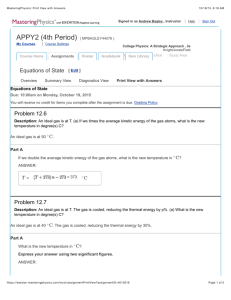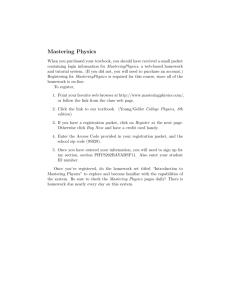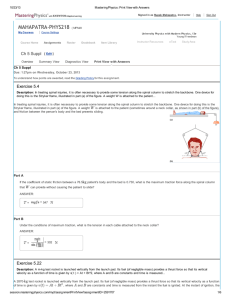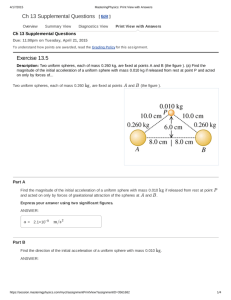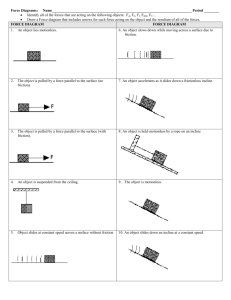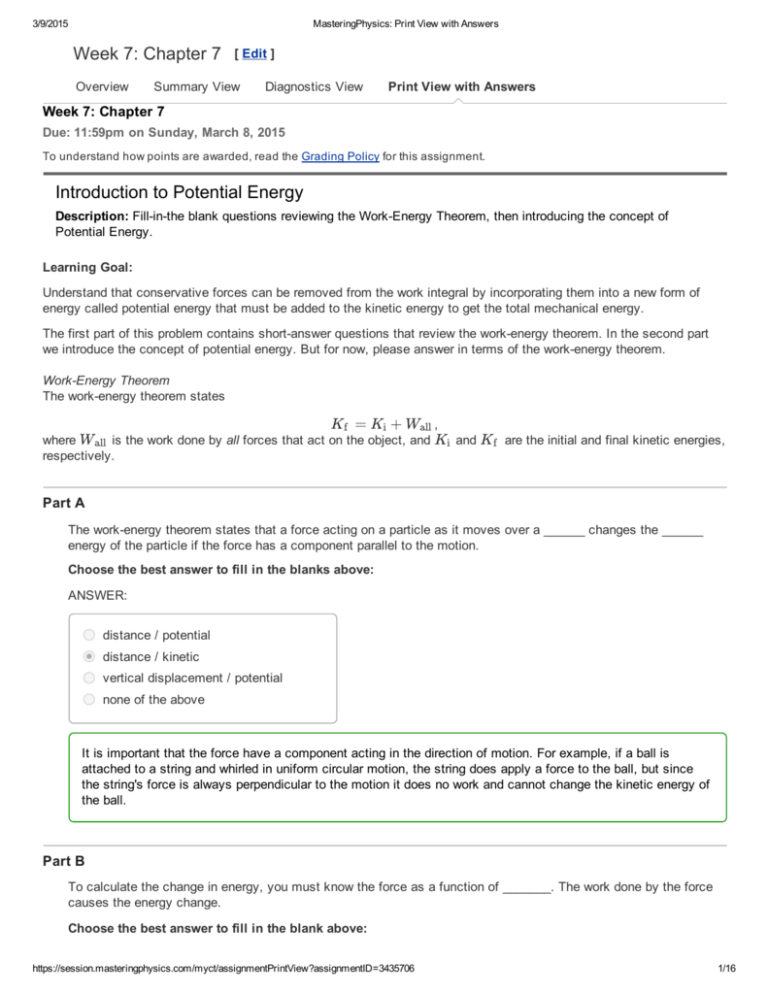
3/9/2015
MasteringPhysics: Print View with Answers
Week 7: Chapter 7
Overview
[ Edit ]
Summary View
Diagnostics View
Print View with Answers
Week 7: Chapter 7
Due: 11:59pm on Sunday, March 8, 2015
To understand how points are awarded, read the Grading Policy for this assignment.
Introduction to Potential Energy
Description: Fill­in­the blank questions reviewing the Work­Energy Theorem, then introducing the concept of
Potential Energy.
Learning Goal:
Understand that conservative forces can be removed from the work integral by incorporating them into a new form of
energy called potential energy that must be added to the kinetic energy to get the total mechanical energy.
The first part of this problem contains short­answer questions that review the work­energy theorem. In the second part
we introduce the concept of potential energy. But for now, please answer in terms of the work­energy theorem.
Work­Energy Theorem The work­energy theorem states
Kf = Ki + W all ,
where W all is the work done by all forces that act on the object, and Ki and Kf are the initial and final kinetic energies,
respectively.
Part A
The work­energy theorem states that a force acting on a particle as it moves over a ______ changes the ______
energy of the particle if the force has a component parallel to the motion.
Choose the best answer to fill in the blanks above:
ANSWER:
distance / potential
distance / kinetic
vertical displacement / potential
none of the above
It is important that the force have a component acting in the direction of motion. For example, if a ball is
attached to a string and whirled in uniform circular motion, the string does apply a force to the ball, but since
the string's force is always perpendicular to the motion it does no work and cannot change the kinetic energy of
the ball.
Part B
To calculate the change in energy, you must know the force as a function of _______. The work done by the force
causes the energy change.
Choose the best answer to fill in the blank above:
https://session.masteringphysics.com/myct/assignmentPrintView?assignmentID=3435706
1/16
3/9/2015
MasteringPhysics: Print View with Answers
ANSWER:
acceleration
work
distance
potential energy
Part C
To illustrate the work­energy concept, consider the case of a stone falling from x i to x f under the influence of
gravity.
Using the work­energy concept, we say that work is done by the gravitational _____, resulting in an increase of the
______ energy of the stone.
Choose the best answer to fill in the blanks above:
ANSWER:
force / kinetic
potential energy / potential
force / potential
potential energy / kinetic
Potential Energy You should read about potential energy in your text before answering the following questions.
Potential energy is a concept that builds on the work­energy theorem, enlarging the concept of energy in the most
physically useful way. The key aspect that allows for potential energy is the existence of conservative forces, forces for
which the work done on an object does not depend on the path of the object, only the initial and final positions of the
object. The gravitational force is conservative; the frictional force is not.
The change in potential energy is the negative of the work done by conservative forces. Hence considering the initial and
final potential energies is equivalent to calculating the work done by the conservative forces. When potential energy is
used, it replaces the work done by the associated conservative force. Then only the work due to nonconservative forces
needs to be calculated.
In summary, when using the concept of potential energy, only nonconservative forces contribute to the work, which now
changes the total energy:
where Uf
,
and Ui are the final and initial potential energies, and W nc is the work due only to nonconservative forces.
K f + Uf
= Ef
= W nc + Ei = W nc + Ki + Ui
Now, we will revisit the falling stone example using the concept of potential energy.
Part D
Rather than ascribing the increased kinetic energy of the stone to the work of gravity, we now (when using potential
energy rather than work­energy) say that the increased kinetic energy comes from the ______ of the _______
energy.
Choose the best answer to fill in the blanks above:
https://session.masteringphysics.com/myct/assignmentPrintView?assignmentID=3435706
2/16
3/9/2015
MasteringPhysics: Print View with Answers
ANSWER:
work / potential
force / kinetic
change / potential
Part E
This process happens in such a way that total mechanical energy, equal to the ______ of the kinetic and potential
energies, is _______.
Choose the best answer to fill in the blanks above:
ANSWER:
sum / conserved
sum / zero
sum / not conserved
difference / conserved
Spring Gun
Description: Simple question about potential energy in a spring being converted to gravitational potential energy of
a ball launched vertically.
A spring­loaded toy gun is used to shoot a ball straight up in the air. The ball reaches a maximum height H , measured
from the equilibrium position of the spring.
Part A
The same ball is shot straight up a second time from the same gun, but this time the spring is compressed only half
as far before firing. How far up does the ball go this time? Neglect friction. Assume that the spring is ideal and that
the distance by which the spring is compressed is negligible compared to H .
https://session.masteringphysics.com/myct/assignmentPrintView?assignmentID=3435706
3/16
3/9/2015
MasteringPhysics: Print View with Answers
Hint 1. Potential energy of the spring
The potential energy of a spring is proportional to the square of the distance the spring is compressed. The
spring was compressed half the distance, so the mass, when launched, has one quarter of the energy as in
the first trial.
Hint 2. Potential energy of the ball
At the highest point in the ball's trajectory, all of the spring's potential energy has been converted into
gravitational potential energy of the ball.
ANSWER:
height = Shooting a Block up an Incline
Description: Shoot an object up an incline (with friction) using a spring­gun. Use energy conservation to find the
distance the object travels up the incline.
A block of mass m is placed in a smooth­bored spring gun at the bottom of the incline so that it compresses the spring
by an amount x c . The spring has spring constant k . The incline makes an angle θ with the horizontal and the coefficient
of kinetic friction between the block and the incline is μ . The block is released, exits the muzzle of the gun, and slides
up an incline a total distance L.
Part A
Find L, the distance traveled along the incline by the block after it exits the gun. Ignore friction when the block is
inside the gun. Also, assume that the uncompressed spring is just at the top of the gun (i.e., the block moves a
distance x c while inside of the gun). Use g for the magnitude of acceleration due to gravity.
Express the distance L in terms of x c , k , m, g , μ , and θ .
Hint 1. How to approach the problem
This is an example of a problem that would be very difficult using only Newton's laws and calculus. Instead,
Ef inal − Einitial = W ext
https://session.masteringphysics.com/myct/assignmentPrintView?assignmentID=3435706
Ef inal
Einitial
4/16
3/9/2015
MasteringPhysics: Print View with Answers
use the Work­Energy Theorem: Ef inal − Einitial = W ext , where Ef inal is the final energy, Einitial is the
initial energy, and W ext is the work done on the system by external forces. Let the gravitational potential
energy be zero before the spring is released. Then, Einitial is the potential energy due to the spring, Ef inal is
the potential energy due to gravity, and W ext is the work done by friction. Once you've set up this equation
completely, solve for L.
Hint 2. Find the initial energy of the block
Find the initial energy Einitial of the block. Take the gravitational potential energy to be zero before the
spring is released.
Express your answer in terms of parameters given in the problem introduction.
Hint 1. Potential energy of a compressed spring
Recall that the potential energy U of a spring with spring constant k compressed a distance x is 2
U = (1/2)kx .
ANSWER:
Einitial
= Hint 3. Find the work done by friction
Find W f riction , the work done by friction on the block.
Express W f riction in terms of L, m, g , μ , and θ .
Hint 1. How to compute work
The work done by a force acting along the direction of motion of an object is equal to the magnitude of
the force times the distance over which the object moves. Work is negative if the force directly
opposes the motion.
ANSWER:
W f riction
= Hint 4. Find the final energy of the block
Find an expression for the final energy Ef inal of the block (the energy when it has traveled a distance L up
the incline). Assume that the gravitational potential energy of the block is zero before the spring is released
and that the block moves a distance x c inside of the gun.
Your answer should contain L and x c .
Hint 1. What form does the energy take?
When the block stops sliding up the ramp, all of its energy is in the form of gravitational potential
energy.
https://session.masteringphysics.com/myct/assignmentPrintView?assignmentID=3435706
5/16
3/9/2015
MasteringPhysics: Print View with Answers
ANSWER:
Ef inal
= ANSWER:
L
= Exercise 7.1
Description: In one day, a m mountain climber ascends from the y level on a vertical cliff to the top at y1. The next
day, she descends from the top to the base of the cliff, which is at an elevation of y2. (a) What is her change in
gravitational potential energy ...
In one day, a 70kg mountain climber ascends from the 1520m level on a vertical cliff to the top at 2340m . The next
day, she descends from the top to the base of the cliff, which is at an elevation of 1300m .
Part A
What is her change in gravitational potential energy on the first day?
ANSWER:
ΔU
= = 5.63×105 J Part B
What is her change in gravitational potential energy on the second day?
ANSWER:
ΔU
= = −7.13×105 J Exercise 7.15
Description: A force of ## N stretches a certain spring a distance of ## m. (a) What is the potential energy of the
spring when it is stretched a distance of ## m? (b) What is its potential energy when it is compressed a distance of
## cm?
A force of 700N stretches a certain spring a distance of 0.200m .
Part A
What is the potential energy of the spring when it is stretched a distance of 0.200m ?
https://session.masteringphysics.com/myct/assignmentPrintView?assignmentID=3435706
6/16
3/9/2015
MasteringPhysics: Print View with Answers
ANSWER:
U1
= = 70.0 J Part B
What is its potential energy when it is compressed a distance of 7.00cm ?
ANSWER:
U2
= = 8.58 J Exercise 7.24
Description: In a "worst­case" design scenario, a 2000­kg elevator with broken cables is falling at 4.00 m/s when it
first contacts a cushioning spring at the bottom of the shaft. The spring is supposed to stop the elevator,
compressing 2.00 m as it does so...
In a "worst­case" design scenario, a 2000­kg elevator with broken cables is falling at 4.00 m/s when it first contacts a
cushioning spring at the bottom of the shaft. The spring is supposed to stop the elevator, compressing 2.00 m as it
does so. During the motion a safety clamp applies a constant 17000­N frictional force to the elevator.
Part A
What is the speed of the elevator after it has moved downward 1.00 m from the point where it first contacts a
spring?
ANSWER:
v
= 3.65 m/s Part B
When the elevator is 1.00 m below point where it first contacts a spring, what is its acceleration?
ANSWER:
a
= 4.00 m/s2 Exercise 7.29 ­ Copy
Description: A ##­kg book slides on a horizontal table. The kinetic friction force on the book has magnitude ## N.
(a) How much work is done on the book by friction during a displacement of ## m to the left? (b) The book now
slides a distance ## m to the right, ...
−kg
https://session.masteringphysics.com/myct/assignmentPrintView?assignmentID=3435706
N
7/16
3/9/2015
MasteringPhysics: Print View with Answers
A 0.66−kg book slides on a horizontal table. The kinetic friction force on the book has magnitude 1.4N .
Part A
How much work is done on the book by friction during a displacement of 2.1m to the left?
Express your answer using two significant figures.
ANSWER:
W
= = ­2.9 J Part B
The book now slides a distance 2.1m to the right, returning to its starting point. During this second displacement of
2.1m , how much work is done on the book by friction?
Express your answer using two significant figures.
ANSWER:
W
= = ­2.9 J Part C
What is the total work done on the book by friction during the complete round trip?
Express your answer using two significant figures.
ANSWER:
W
= = ­5.9 J Part D
On the basis of your answer to part (C), would you say that the friction force is conservative or nonconservative?
ANSWER:
conservative
nonconservative
Exercise 7.38
Description: A marble moves along the x­axis. The potential­energy function is shown in the figure . (a) At which of
the labeled x­coordinates is the force on the marble zero? (b) Which of the labeled x­coordinates is a position of
stable equilibrium? (c) Which ...
A marble moves along the x ­axis. The potential­energy function is shown in the figure .
https://session.masteringphysics.com/myct/assignmentPrintView?assignmentID=3435706
8/16
3/9/2015
MasteringPhysics: Print View with Answers
Part A
At which of the labeled x ­coordinates is the force on the marble zero?
ANSWER:
a and c
b and d
Part B
Which of the labeled x ­coordinates is a position of stable equilibrium?
ANSWER:
a
b
c
d
Part C
Which of the labeled x ­coordinates is a position of unstable equilibrium?
ANSWER:
a
b
c
d
https://session.masteringphysics.com/myct/assignmentPrintView?assignmentID=3435706
9/16
3/9/2015
MasteringPhysics: Print View with Answers
Problem 7.42
Description: A 2.00­kg block is pushed against a spring with negligible mass and force constant k = 400 N/m,
compressing it 0.220 m. When the block is released, it moves along a frictionless, horizontal surface and then up a
frictionless incline with slope...
A 2.00­kg block is pushed against a spring with negligible mass and force constant k = 400 N/m , compressing it 0.220
m . When the block is released, it moves along a frictionless, horizontal surface and then up a frictionless incline with
slope 37.0∘ .
Part A
What is the speed of the block as it slides along the horizontal surface after having left the spring?
ANSWER:
v
= 3.11 m/s Part B
How far does the block travel up the incline before starting to slide back down?
ANSWER:
L
= 0.821 m Problem 7.46
Description: A car in an amusement park ride rolls without friction around the track shown in the figure . It starts
from rest at point A at a height h above the bottom of the loop. Treat the car as a particle. (a) What is the minimum
value of h (in terms of R)...
A car in an amusement park ride rolls without friction around the track shown in the figure . It starts from rest at point A
at a height h above the bottom of the loop. Treat the car as a
particle.
https://session.masteringphysics.com/myct/assignmentPrintView?assignmentID=3435706
10/16
3/9/2015
MasteringPhysics: Print View with Answers
Part A
What is the minimum value of h (in terms of R) such that the car moves around the loop without falling off at the
top (point B)?
ANSWER:
h min
= Also accepted: Part B
If the car starts at height h = 3.50 R and the radius is R = 17.0m , compute the speed of the passengers when
the car is at point C , which is at the end of a horizontal diameter.
ANSWER:
vC
= = 28.9 m/s Part C
If the car starts at height h = 3.50 R and the radius is R = 17.0m , compute the radial acceleration of the
passengers when the car is at point C , which is at the end of a horizontal diameter.
ANSWER:
a rad
= = 49.0 m/s2 Part D
h =
R
R
https://session.masteringphysics.com/myct/assignmentPrintView?assignmentID=3435706
11/16
3/9/2015
MasteringPhysics: Print View with Answers
If the car starts at height h = 3.50 R and the radius is R = 17.0m , compute the tangential acceleration of the
passengers when the car is at point C , which is at the end of a horizontal diameter.
ANSWER:
|a tan |
= 9.80 m/s2 Problem 7.49
Description: A m stone slides down a snow­covered hill (the figure ), leaving point A with a speed of v. There is no
friction on the hill between points A and B, but there is friction on the level ground at the bottom of the hill, between
B and the wall. After...
A 15.0kg stone slides down a snow­covered hill (the figure ),
leaving point A with a speed of 10.0m/s . There is no friction
on the hill between points A and B, but there is friction on the
level ground at the bottom of the hill, between B and the wall.
After entering the rough horizontal region, the stone travels 100
m and then runs into a very long, light spring with force
constant 2.50N/m . The coefficients of kinetic and static
friction between the stone and the horizontal ground are 0.20
and 0.80, respectively.
Part A
What is the speed of the stone when it reaches point B?
ANSWER:
v2
= = 22.2 m/s Part B
How far will the stone compress the spring?
ANSWER:
x
= https://session.masteringphysics.com/myct/assignmentPrintView?assignmentID=3435706
= 15.4 m 12/16
3/9/2015
MasteringPhysics: Print View with Answers
Part C
Will the stone move again after it has been stopped by the spring?
ANSWER:
yes
no
Problem 7.62
Description: A ##­kg skier starts from rest at the top of a ski slope of height ## m. (a) If frictional forces do ## J of
work on her as she descends, how fast is she going at the bottom of the slope? (b) Now moving horizontally, the
skier crosses a patch of...
A 64.0­kg skier starts from rest at the top of a ski slope of height 70.0m .
Part A
If frictional forces do −1.06×104J of work on her as she descends, how fast is she going at the bottom of the slope?
Take free fall acceleration to be g = 9.80m/s2 .
ANSWER:
v
= = 32.3 m/s Part B
Now moving horizontally, the skier crosses a patch of soft snow, where the coefficient of friction is 0.24. If the patch
is of width 62.0m and the average force of air resistance on the skier is 180N , how fast is she going after crossing
the patch?
ANSWER:
v
= = 20.0 m/s Part C
After crossing the patch of soft snow, the skier hits a snowdrift and penetrates a distance 2.4m into it before
coming to a stop. What is the average force exerted on her by the snowdrift as it stops her?
ANSWER:
https://session.masteringphysics.com/myct/assignmentPrintView?assignmentID=3435706
13/16
3/9/2015
MasteringPhysics: Print View with Answers
F
= = 5340 N Problem 7.66
Description: A truck with mass m has a brake failure while going down an icy mountain road of constant downward
slope angle alpha . Initially the truck is moving downhill at speed v_0. After careening downhill a distance L with
negligible friction, the truck...
A truck with mass m has a brake failure while going down an icy mountain road of constant downward slope angle α .
Initially the truck is moving downhill at speed v 0 . After
careening downhill a distance L with negligible friction, the
truck driver steers the runaway vehicle onto a runaway truck
ramp of constant upward slope angle β . The truck ramp has a
soft sand surface for which the coefficient of rolling friction is μ .
r
Part A
What is the distance that the truck moves up the ramp before coming to a halt? Solve using energy methods.
Express your answer in terms of m, α, v 0 , L, g , β and μ r .
ANSWER:
x
= Problem 7.67
Description: A certain spring is found not to obey Hooke's law; it exerts a restoring force F_x(x)= ­ alpha x­ beta
x^2 if it is stretched or compressed, where alpha = 60.0 (N/m) and beta = 18.0 (N/m^2). The mass of the spring is
negligible. (a) Calculate the ...
A certain spring is found not to obey Hooke's law; it exerts a restoring force Fx (x) = −αx − βx 2 if it is stretched or
compressed, where α = 60.0 N/m and β = 18.0 N/m 2 . The mass of the spring is negligible.
Part A
U (x)
https://session.masteringphysics.com/myct/assignmentPrintView?assignmentID=3435706
U = 0
x = 0
14/16
3/9/2015
MasteringPhysics: Print View with Answers
Calculate the potential energy function U (x) for this spring. Let U
= 0
when x
= 0
.
Express your answer in terms of x .
ANSWER:
U (x)
= Part B
An object with mass 0.900 kg on a frictionless, horizontal surface is attached to this spring, pulled a distance 1.00 m to the right (the + x ­ direction) to stretch the spring, and released. What is the speed of the object when it
is 0.50 m to the right of the x = 0 equilibrium position?
ANSWER:
v2
= 7.85 m/s Problem 7.81
Description: A wooden block with mass ## kg is placed against a compressed spring at the bottom of a slope
inclined at an angle of ## degree(s) (point A). When the spring is released, it projects the block up the incline. At
point B, a distance of ## m up the...
A wooden block with mass 1.85kg is placed against a compressed spring at the bottom of a slope inclined at an angle
of 35.0∘ (point A). When the spring is released, it projects the block up the incline. At point B, a distance of 4.85m up
the incline from A, the block is moving up the incline at a speed of 5.70m/s and is no longer in contact with the spring.
The coefficient of kinetic friction between the block and incline is μ k = 0.55. The mass of the spring is negligible.
Part A
Calculate the amount of potential energy that was initially stored in the spring.
Take free fall acceleration to be 9.80m/s2 .
ANSWER:
U1
= = 120 J Problem 7.82
Description: A small rock with mass 0.12 kg is fastened to a massless string with length 0.80 m to form a
pendulum. The pendulum is swinging so as to make a maximum angle of 45 degree(s) with the vertical. Air
resistance is negligible. (a) What is the speed of...
A small rock with mass 0.12 kg is fastened to a massless string with length 0.80 m to form a pendulum. The pendulum
is swinging so as to make a maximum angle of 45 ∘ with the vertical. Air resistance is negligible.
Part A
https://session.masteringphysics.com/myct/assignmentPrintView?assignmentID=3435706
15/16
3/9/2015
MasteringPhysics: Print View with Answers
What is the speed of the rock when the string passes through the vertical position?
Express your answer using two significant figures.
ANSWER:
v
= 2.1 m/s Part B
What is the tension in the string when it makes an angle of 45 ∘ with the vertical?
Express your answer using two significant figures.
ANSWER:
0.83 N Part C
What is the tension in the string as it passes through the vertical?
Express your answer using two significant figures.
ANSWER:
1.9 N Copyright © 2015 Pearson. All rights reserved.
Legal Notice
Privacy Policy
https://session.masteringphysics.com/myct/assignmentPrintView?assignmentID=3435706
Permissions
16/16

